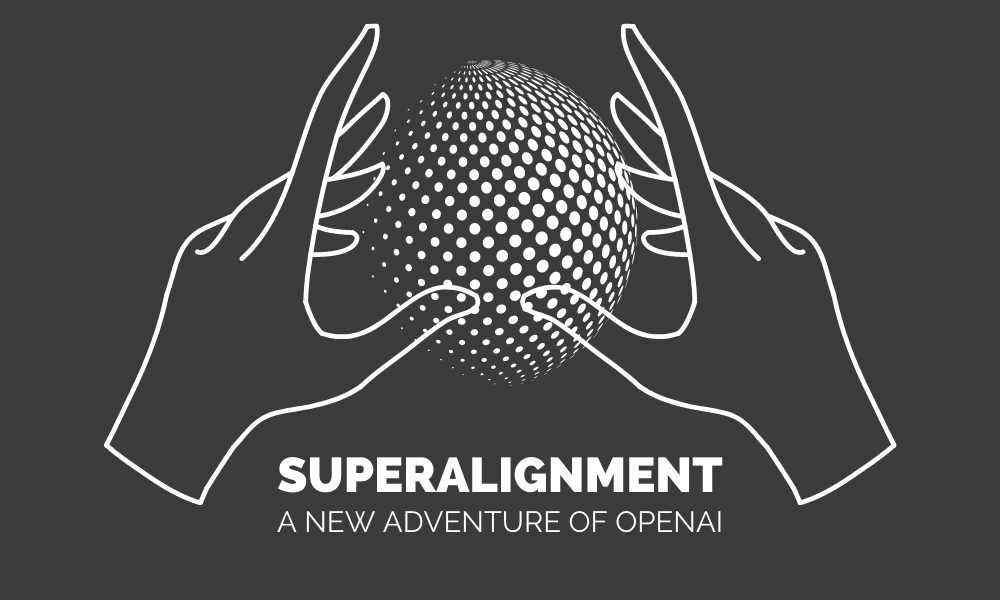What is Superalignment & Why It is Important?
Addressing the potential risks associated with superintelligence systems.

Image by Author
Superintelligence has the potential to be the most significant technological advancement in human history. It can help us tackle some of the most pressing challenges faced by humanity. While it can bring about a new era of progress, it also poses certain inherent risks that must be handled cautiously. Superintelligence can disempower humanity or even lead to human extinction if not appropriately handled or aligned correctly.
While superintelligence may seem far off, many experts believe it could become a reality in the next few years. To manage the potential risks, we must create new governing bodies and address the critical issue of superintelligence alignment. It means ensuring that artificial intelligence systems that will soon surpass human intelligence remain aligned with human goals and intentions.
In this blog, we will learn about Superalignmnet and learn about OpenAI’s approach to solving the core technical challenges of superintelligence alignment.
What is Superalignment
Superalignment refers to ensuring that super artificial intelligence (AI) systems, which surpass human intelligence in all domains, act according to human values and goals. It is an essential concept in the field of AI safety and governance, aiming to address the risks associated with developing and deploying highly advanced AI.
As AI systems get more intelligent, it may become more challenging for humans to understand how they make decisions. It can cause problems if the AI acts in ways that go against human values. It's essential to address this issue to prevent any harmful consequences.
Superalignment ensures that superintelligent AI systems act in ways that align with human values and intentions. It requires accurately specifying human preferences, designing AI systems that can understand them, and creating mechanisms to ensure the AI systems pursue these objectives.
Why do we need Superalignment
Superalignment plays a crucial role in addressing the potential risks associated with superintelligence. Let's delve into the reasons why we need Superalignment:
- Mitigating Rogue AI Scenarios: Superalignment ensures that superintelligent AI systems align with human intent, reducing the risks of uncontrolled behavior and potential harm.
- Safeguarding Human Values: By aligning AI systems with human values, Superalignment prevents conflicts where superintelligent AI may prioritize objectives incongruent with societal norms and principles.
- Avoiding Unintended Consequences: Superalignment research identifies and mitigates unintended adverse outcomes that may arise from advanced AI systems, minimizing potential adverse effects.
- Ensuring Human Autonomy: Superalignment focuses on designing AI systems as valuable tools that augment human capabilities, preserving our autonomy and preventing overreliance on AI decision-making.
- Building a Beneficial AI Future: Superalignment research aims to create a future where superintelligent AI systems contribute positively to human well-being, addressing global challenges while minimizing risks.
OpenAI Approach
OpenAI is building a human-level automated alignment researcher that will use vast amounts of compute to scale the efforts, and iteratively align superintelligence - Introducing Superalignment (openai.com).
To align the first automated alignment researcher, OpenAI will need to:
- Develop a scalable training method: OpenAI can use AI systems to help evaluate other AI systems on difficult tasks that are hard for humans to assess.
- Validate the resulting model: OpenAI will automate search for problematic behavior and problematic internals.
- Adversarial testing: Test the AI system by purposely training models that are misaligned, and verify that the methods used can identify even the most severe misalignments in the pipeline.
Team
OpenAI is forming a team to tackle the challenge of superintelligence alignment. They will allocate 20% of their computing resources over the next four years. The team will be led by Ilya Sutskever and Jan Leike, and includes members from previous alignment teams and other departments within the company.
OpenAI is currently seeking exceptional researchers and engineers to contribute to its mission. The problem of aligning superintelligence is primarily related to machine learning. Experts in the field of machine learning, even if they are not currently working on alignment, will play a crucial role in finding a solution.
Goals
OpenAI has set a goal to address the technical challenges of superintelligence alignment within four years. Although this is an ambitious objective and success is not guaranteed, OpenAI remains optimistic that a focused and determined effort can lead to a solution for this problem.
To solve the problem, they must present convincing evidence and arguments to the machine learning and safety community. Having a high level of confidence in the proposed solutions is crucial. If the solutions are unreliable, the community can still use the findings to plan accordingly.
Conclusion
OpenAI's Superalignment initiative holds great promise in addressing the challenges of superintelligence alignment. With promising ideas emerging from preliminary experiments, the team has access to increasingly useful progress metrics and can leverage existing AI models to study these problems empirically.
It's important to note that the Superalignment team's efforts are complemented by OpenAI's ongoing work to improve the safety of current models, including the widely used ChatGPT. OpenAI remains committed to understanding and mitigating various risks associated with AI, such as misuse, economic disruption, disinformation, bias and discrimination, addiction, and overreliance.
OpenAI aims to pave the way for a safer and more beneficial AI future through dedicated research, collaboration, and a proactive approach.
Abid Ali Awan (@1abidaliawan) is a certified data scientist professional who loves building machine learning models. Currently, he is focusing on content creation and writing technical blogs on machine learning and data science technologies. Abid holds a Master's degree in Technology Management and a bachelor's degree in Telecommunication Engineering. His vision is to build an AI product using a graph neural network for students struggling with mental illness.
